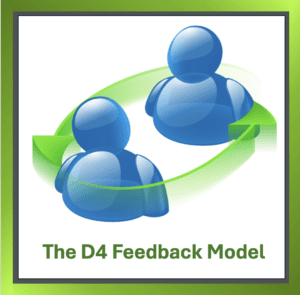The D4 Feedback Model: A Comprehensive Framework for Meaningful Communication
In today’s workplace, effective feedback is essential for growth and development. While many feedback models exist, the D4 Feedback Model stands out for its holistic approach that addresses not just what happened, but also the emotional and interpretative dimensions of workplace interactions.

The D4 Feedback Model facilitates meaningful workplace dialogue by focusing on data, emotions, and interpretations.
This comprehensive framework helps create meaningful dialogue that leads to genuine understanding and positive change.
Understanding the D4 Feedback Model
The D4 Feedback Model comprises four essential components that together create a complete picture of a situation:
- Data: Establishing the Facts
The foundation of the D4 model begins with objective information, the unfiltered facts of what actually occurred. This step requires participants to:
- Focus solely on observable events
- Avoid assumptions, judgments, or interpretations
- Describe specific actions, words, or behaviours
- Use concrete examples that everyone can agree occurred
For example, instead of saying “You were unprofessional in the meeting,” you might say “During yesterday’s client meeting, you arrived 10 minutes late and interrupted the presentation twice.”
This factual foundation ensures everyone starts with a shared understanding of what actually happened, creating common ground for the rest of the conversation.
- Depth of Feeling: Acknowledging Emotions
The second component addresses the emotional impact of the situation. This crucial step recognises that emotions influence workplace interactions significantly and shouldn’t be ignored.
During this phase, participants:
- Identify and name the emotions experienced
- Express feelings without judgment
- Acknowledge emotions as valid experiences
- Create space for different emotional responses
For instance: “When this happened, I felt frustrated and concerned about how the client might perceive our team.”
By acknowledging emotions openly, the D4 model prevents unaddressed feelings from undermining the feedback process and creates psychological safety for honest dialogue.
- Dramatic Interpretation: Exploring Perspectives
The third component delves into how participants interpreted the situation, the meaning they attached to what happened. This step recognises that people naturally create narratives to make sense of events, and these interpretations heavily influence reactions.
This phase involves:
- Sharing personal interpretations of what occurred
- Exploring assumptions made about intentions or motivations
- Discussing different perspectives on the same situation
- Recognising that interpretations aren’t facts
For example: “I interpreted your late arrival as indicating this client wasn’t a priority for you, though I recognise that might not have been your intention.”
This step helps uncover misunderstandings and reveals how different people can experience the same situation in vastly different ways.
- Do: Identifying Actions and Outcomes
The final component focuses on what was done or could be done in response to the situation and what results were achieved or desired . This action-oriented phase bridges understanding with forward movement.
In this step, participants:
- Discuss actions taken in response to the situation
- Evaluate the effectiveness of those actions
- Identify alternative approaches that might have worked better
- Agree on specific next steps or future behaviours
For example: “You apologised to the client after the meeting, which helped repair the relationship. In the future, if you’re running late, sending a quick message would help us adjust accordingly.”
This component ensures the feedback process leads to concrete improvements rather than remaining theoretical.
Benefits of the D4 Feedback Model
The D4 model offers several advantages over simpler feedback frameworks:
- Comprehensive understanding: By addressing facts, feelings, interpretations, and actions, it captures the full complexity of workplace interactions.
- Emotional intelligence: The model explicitly acknowledges emotions, helping build emotional awareness and intelligence.
- Perspective-taking: The “Dramatic Interpretation” component helps people understand different viewpoints, building empathy and reducing conflict.
- Reduced defensiveness: By separating facts from interpretations, the model helps recipients distinguish between what actually happened and what was perceived.
- Action orientation: The “Do” component ensures conversations lead to practical improvements rather than just insight.
Implementing the D4 Feedback Model
To effectively use this model:
- Create psychological safety: Establish that the purpose is growth and understanding, not judgment.
- Allow adequate time: The D4 model requires more time than simpler feedback approaches but delivers more lasting results.
- Practice active listening: Each person should have uninterrupted time to share their perspective on all four components.
- Use “I” statements: Particularly in the “Depth of Feeling” and “Dramatic Interpretation” phases to take ownership of emotions and perspectives.
- Be patient: Moving through all components requires time and openness for effective communication.
